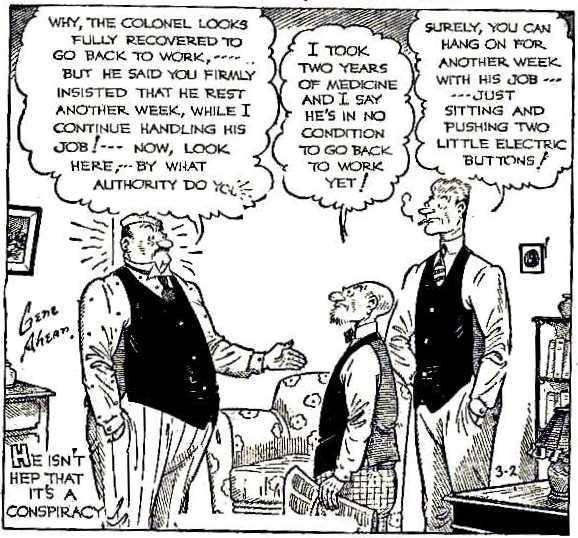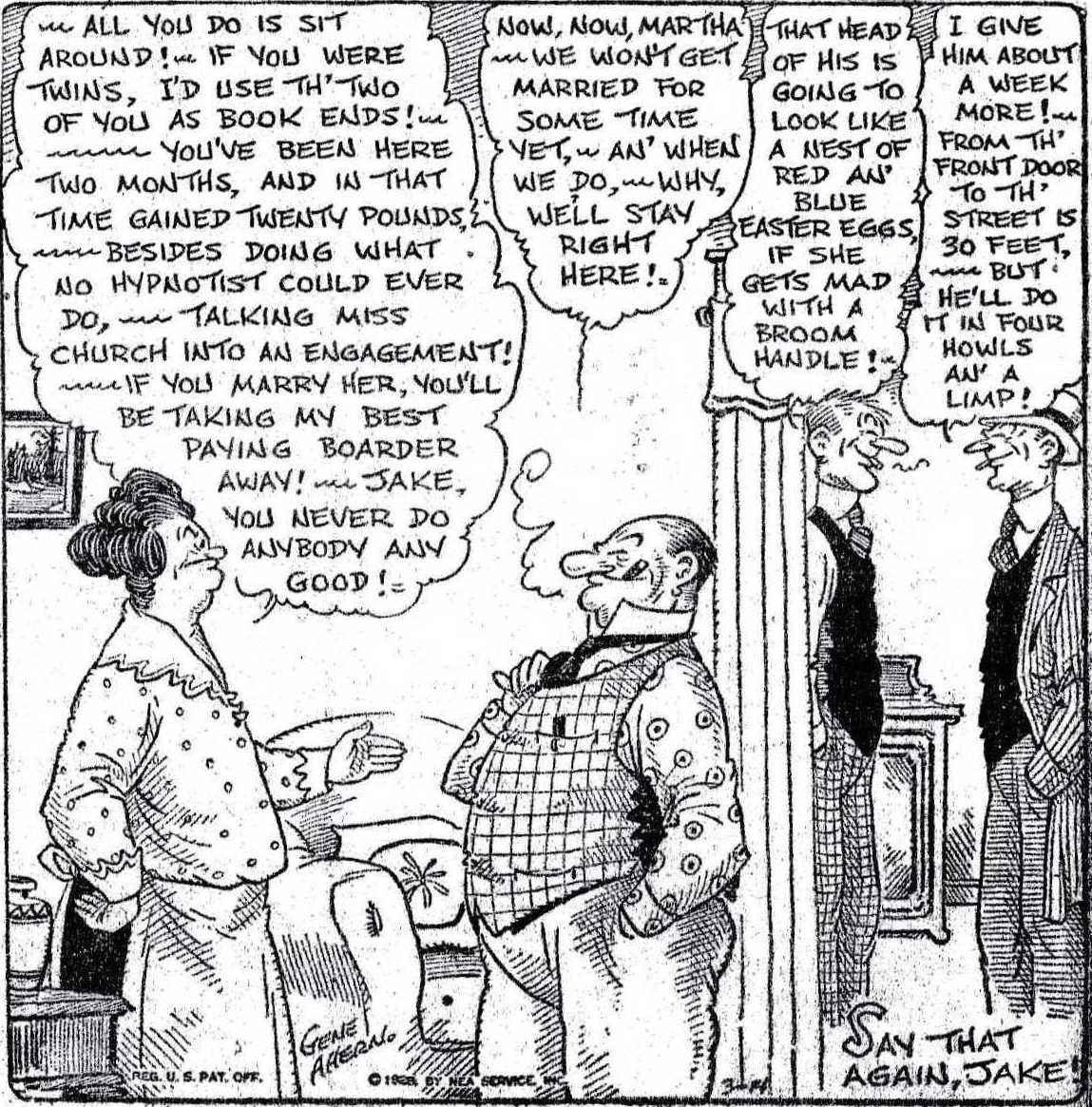


We are pleased to offer another collection of strips from Comic Preserves by the great Gene Ahern. (See The Squirrel Cage, Board and Room a.k.a. Room and Board, and Our Boarding House a.k.a. Major Hoople). Eugene Leslie Ahern (1895 Ė March 6, 1960) was a cartoonist best known for his bombastic Major Hoople, a pompous character who appeared in the long-run syndicated gag panel Our Boarding House. Many of Ahernís comic strips took a surreal or screwball approach, notably his nonsensical catch phrase ďNov shmoz ka pop.Ē After three years study at the Chicago Art Institute, Ahern went to Cleveland and worked for the NEA syndicate (1914-15) as a sportwriter and artist, initially inking comic drawings for $18 a week. He worked on such strips as Dream Dope, Fathead Fritz, Sporty Sid and his Pals, Taking Her to the Ball Game, Ainít Nature Wonderful, Squirrel Food, Balmy Benny and Otto Auto, about a man who loved driving so much that he couldnít stop. Ahern was making an annual $35,000 at NEA, and King Features Syndicate offered to double that figure. Leaving NEA in March 1936 for King Features, Ahern created Room and Board (1936-58). A resident in that boarding house was Judge Puffle, very much in the Hoople tradition. Knock-offs, such as Associated Pressís Mister Gilfeather (which, by the way, was handled at various times by both Al Capp and Milton Caniff, before they hit it big with Liíl Abner and Terry & the Pirates, respectively), began to proliferate. In fact, it was a knock-off that took Ahern away from his creation. King Features launched one called Room & Board, starring the very Hoople-like Judge Puffle, in 1936, and hired Ahern himself to write and draw it. This was a reprise of a move King had made nine years earlier, hiring George Swanson (Elza Poppin) to produce a duplicate of his own NEA strip, Salesman Sam, and it had a similar result ó success, but not to the extent of the original. When, in 1953, Ahern retired, Room & Board ended. We hope you enjoy these strips originally published in 1943.
Volumes 1-2 is collected in a single hardcover volume and reprints dailies from 1/2/1943-9/15/1943. Available on Complete Inventory USB, 232 black & white pages.

Small-town humor was a mainstay of comic strips published through World War II. These books print two good examples: The Old Home Town by Lee W. Stanley and Board and Room by Gene Ahern. The Old Home Town was a daily non-continuity panel gag strip centering around the citizens of a small town. Recurring characters include Ed Wurgler - the laziest man in town, he has more stray dogs than the pound. Marshall Otey Walker - the old man doesnít have an ounce of courage in his body. And Grandpappy Gale Windpenny - the town blowhard. Not much else is known about The Old Home Town, which is a pity because it shows small town humor with a delightful zany edge. Created by Lee W. Stanley most sources credit the strip as running from 1925-1948, although some sources peg it as 1921-1966. In any event, it was hardly a flash in the pan, and we are happy to preserve a run of this strip here in this volume. More well-known is the work of Gene Ahern. He began his comics career in 1914, at age 19, when he worked as an inker for NEA in their Chicago office. He created a number of comic strips, none of which attained any real popularity, such as, Auto Otto, Squirrel Food, Ainít Nature Wonderful, and Crazy Quilt. In 1921, NEAís managing editor suggested that Ahern draw a comic strip which took place in a boarding house. Ahern came up with the idea of Our Boarding House (aka Major Hoople). Our Boarding House was dominated by Major Amos B. Hoople, a genial, full-sized, bulbous braggart. Hoople was perhaps comics greatest windbag, stuffed shirt, and blowhard. His wife Martha ran the boarding house the way a Sherman tank might run a stop sign. Our Boarding House was in the top ten in terms of popularity. However, by 1936, King Features offered Ahern more money to create a knock-off for them. Hence was born Board and Room, successful, but not quite to the same extent as itís predecessor. The characters were much in the same tradition. Where Our Boarding House had Major Hoople, Board and Room had Judge Puffle. Board and Room ran from 1936 until Ahernís death in 1953. Our Boarding House continued under other hands until 1981.
Volumes 1-3 reprints Board & Room strips from 3/4/40-10/5/40 and some Old Home Town strips from 1938
. All three volumes are available on Complete Inventory USB, 240 black and white pages.

Compare and contrast! Our Boarding House was syndicated as a daily cartoon in hundreds of newspapers from 1921 until 1981. The best years were from 1921 to 1936 when the originator, Gene Ahern, was drawing the cartoons. During this period, boarding houses were an institution in our society. It was the home away from home where men lived to save money until they got married and moved into a home of their own. Women in the same situation usually "took rooms" with a family. Many boarding houses came into being because the main wage earner of the day, usually the husband, was not doing an adequate job of supporting the household. It is doubtful that many men were as bizarre as Major Hoople, with his get-rich-quick schemes and his morbid fear of work. Mrs. Hoople was the practical, hard-working antithesis of the Major's approach. The resulting interaction was the core of the panel for 60 years. Reprints strips from 1/2/1928-3/24/1928. Available on Complete Inventory USB, 72 black and white pages.
MAIN PAGE